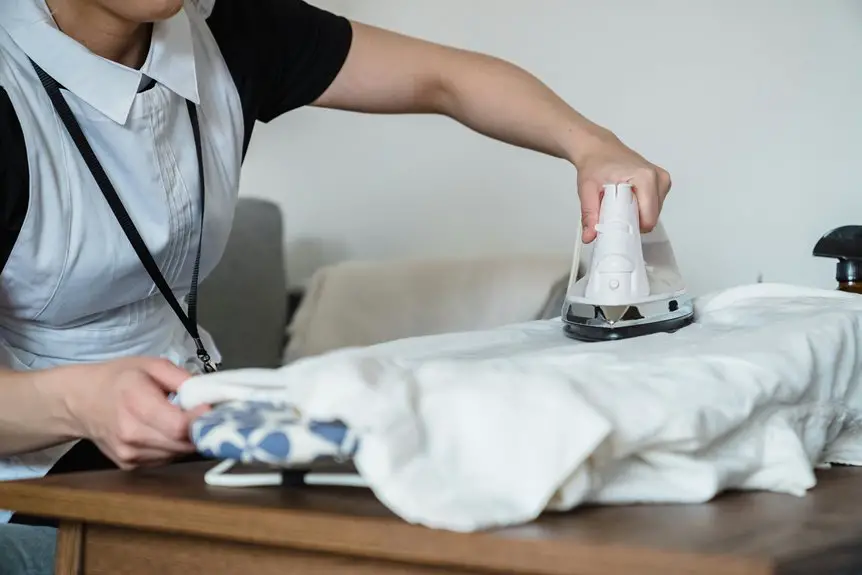You can wash nonwoven fabric, but you’ll need to be gentle to avoid damage. Hand wash it with cool or lukewarm water using mild detergent, and avoid wringing or twisting. If you use a machine, choose a delicate cycle with cold water and skip spinning. Always air dry flat, away from direct heat or sunlight to keep fibers strong. Taking these steps helps maintain nonwoven fabrics longer, yet there’s more to learn about proper care and replacement.
Table of Contents
Key Takeaways
- Nonwoven fabrics can be gently hand washed with cool or lukewarm water using mild detergent to avoid fiber damage.
- Machine washing is possible on a delicate, cold cycle without spinning, but frequent washing may reduce fabric durability.
- Always air dry nonwoven fabrics flat or hung loosely, avoiding heat sources like tumble dryers or direct sunlight.
- Spot clean with a damp cloth and mild detergent, avoiding soaking or harsh chemicals to maintain fabric integrity.
- Store nonwoven fabrics in dry, ventilated areas to prevent moisture buildup and prolong their lifespan.
Understanding Nonwoven Fabric Composition
Although you mightn’t realize it, nonwoven fabrics differ markedly from traditional woven or knitted textiles. You’re dealing with materials made by bonding fibers together through chemical, mechanical, heat, or solvent treatment instead of weaving or knitting threads.
Nonwoven fabrics form by bonding fibers chemically or mechanically, unlike woven textiles made by threading.
This process creates a fabric that’s usually lightweight, durable, and often disposable. The fibers can be natural, synthetic, or a blend, depending on the intended use.
Since the fibers aren’t interlaced, nonwoven fabrics often have a different texture and strength profile compared to traditional fabrics. When you handle nonwoven materials, you’ll notice they might feel less flexible but can offer excellent absorbency, filtration, or barrier properties.
Understanding this composition helps you appreciate why their care and cleaning methods differ from those of woven fabrics.
Differences Between Nonwoven and Woven Fabrics
Nonwoven fabrics stand apart from woven fabrics not just in how they’re made but also in how they perform and feel.
While woven fabrics are created by interlacing yarns in a structured pattern, nonwoven fabrics form from fibers bonded through heat, chemicals, or mechanical processes.
This makes nonwovens generally softer, more flexible, and less durable than woven fabrics.
You’ll notice woven fabrics offer greater strength and breathability thanks to their tight weave, whereas nonwovens excel in disposable or lightweight applications due to their porous, less dense structure.
When it comes to washing, the structural differences mean nonwovens often require gentler care to avoid damage, unlike woven fabrics that usually withstand regular laundering.
Understanding these distinctions helps you handle each fabric type properly.
Common Uses of Nonwoven Fabrics
You’ll find nonwoven fabrics in a wide range of everyday products, thanks to their versatility and cost-effectiveness.
When you pick up disposable face masks, you’re holding nonwoven fabric designed for breathability and filtration. In your kitchen, nonwoven fabric serves as cleaning wipes that trap dirt and germs efficiently. You’ll also see it in medical settings, used for surgical gowns, caps, and drapes to maintain hygiene.
At home, nonwoven materials appear in furniture padding and mattress covers, providing comfort and durability. Even in gardening, you can use nonwoven fabrics as weed barriers or plant protection.
Knowing these common uses helps you understand why nonwoven fabrics have become an essential part of modern life, balancing performance with affordability.
How Nonwoven Fabrics React to Water
When water comes into contact with nonwoven fabrics, their reaction depends largely on the material’s composition and manufacturing process.
Some nonwoven fabrics repel water due to hydrophobic fibers or chemical treatments, so water beads up on the surface without soaking in.
Others absorb water quickly, especially if made from hydrophilic fibers like rayon or cellulose-based materials.
You’ll notice that water can weaken certain nonwovens by breaking down fiber bonds or causing swelling, which may alter texture or strength.
In some cases, water exposure can cause shrinking or distortion, especially if the fabric isn’t heat-set.
Understanding how your specific nonwoven fabric reacts to water helps you anticipate changes and handle it carefully, avoiding damage before you even consider washing or cleaning methods.
Recommended Washing Methods for Nonwoven Materials
Since water can affect nonwoven fabrics in various ways—sometimes weakening or distorting them—choosing the right washing method matters a lot.
To protect your nonwoven items, always opt for gentle hand washing with cool or lukewarm water. Avoid wringing or twisting the fabric, as this can cause damage.
Always hand wash nonwoven fabrics gently with cool water, avoiding wringing or twisting to prevent damage.
If you must use a washing machine, select a delicate or gentle cycle with cold water to minimize stress on the fibers. Skip the spin cycle or use a very low setting to prevent deformation.
After washing, lay the fabric flat on a clean towel to air dry, steering clear of direct sunlight and heat sources. This careful approach helps maintain the fabric’s integrity and prolongs its lifespan without causing unnecessary wear or shrinking.
Suitable Detergents and Cleaning Agents
Although nonwoven fabrics require gentle care, choosing the right detergent is crucial to avoid damaging their delicate fibers.
You should opt for mild, liquid detergents that are free from bleach, enzymes, and harsh chemicals. These ingredients can weaken or discolor the fabric.
Avoid powdered detergents, as they may not dissolve completely, leaving residues behind. If you want to freshen up your nonwoven fabric, consider using a gentle fabric softener sparingly, but always test it first to verify it doesn’t affect the material’s properties.
For spot cleaning, use a diluted solution of mild soap and water applied with a soft cloth.
Always steer clear of abrasive cleaners or solvents, which can cause irreparable harm to the fabric’s structure and appearance.
Drying Techniques to Preserve Nonwoven Fabric Integrity
When drying your nonwoven fabric, air drying is your best bet to keep it intact and avoid shrinkage.
You’ll want to steer clear of high heat, which can weaken the fibers and cause damage.
Letting the fabric dry naturally helps preserve its strength and shape over time.
Air Drying Benefits
If you want to keep your nonwoven fabric in top condition, air drying is one of the best methods to use.
It helps maintain the fabric’s strength and shape without exposing it to harsh conditions.
Here are four key benefits of air drying your nonwoven fabric:
- Preserves Integrity: Air drying prevents fibers from weakening or melting.
- Prevents Shrinkage: It avoids the fabric shrinking, which can happen with heat-based drying.
- Maintains Texture: The fabric retains its original feel and appearance.
- Eco-Friendly: Air drying uses no electricity, making it a sustainable choice.
Avoiding Heat Damage
Since nonwoven fabrics are sensitive to high temperatures, you should avoid using heat-based drying methods like tumble dryers or direct sunlight. High heat can cause these fabrics to shrink, warp, or weaken, reducing their lifespan.
Instead, opt for air drying in a shaded, well-ventilated area. Lay the fabric flat or hang it loosely to maintain its shape and allow moisture to evaporate evenly.
If you’re in a hurry, gently pat the fabric with a towel to remove excess water before air drying, but never wring or twist it.
Tips to Extend the Life of Nonwoven Products
To keep your nonwoven products lasting longer, store them properly in a dry, cool place away from direct sunlight.
Use gentle cleaning methods to avoid damaging the fibers, and be careful not to expose them to excessive moisture.
Following these simple steps will help maintain their strength and appearance over time.
Proper Storage Techniques
Although nonwoven fabrics are durable, proper storage plays a vital role in maintaining their quality and extending their lifespan.
You’ll want to follow these key tips to keep your nonwoven products in top shape:
- Store in a cool, dry place away from direct sunlight to prevent fading and weakening.
- Keep nonwoven items in breathable containers or bags to allow air circulation and avoid moisture buildup.
- Avoid heavy stacking or folding that can cause creases or deformation over time.
- Ascertain the storage area is clean to prevent dust and dirt from settling on the fabric.
Gentle Cleaning Methods
When you want to keep your nonwoven fabric looking its best, choosing gentle cleaning methods is crucial.
Start by using a soft brush or cloth to remove surface dirt without damaging the fibers. If you need to spot clean, dab the area with a mild detergent diluted in water, avoiding harsh chemicals that could weaken the material.
Always test any cleaner on a small, hidden spot first to verify it won’t cause discoloration. Use cool or lukewarm water during cleaning to maintain the fabric’s integrity.
After cleaning, gently blot the fabric with a dry towel to absorb excess moisture.
Avoiding Excessive Moisture
Since nonwoven fabrics are sensitive to water, you should avoid exposing them to excessive moisture to keep them in good condition.
Too much water can weaken fibers, cause deformation, and reduce the fabric’s lifespan.
To protect your nonwoven products, follow these tips:
- Use a damp cloth for spot cleaning instead of soaking the entire fabric.
- Avoid machine washing or submerging nonwoven items in water.
- Dry nonwoven fabrics immediately if they get wet to prevent mold and damage.
- Store nonwoven products in a dry, well-ventilated area away from humidity.
When to Replace Nonwoven Fabric Items
You should replace nonwoven fabric items once you notice significant wear or damage, as their durability is limited compared to woven fabrics.
If you see fraying edges, thinning areas, or holes developing, it’s time to switch them out. Nonwoven fabrics don’t hold up well to repeated washing or heavy use, so deterioration can happen quickly.
Also, if the fabric starts losing its texture, becoming stiff or crumbly, replacement guarantees you maintain the item’s functionality and appearance.
For single-use or hygiene products made from nonwoven fabric, always follow manufacturer guidelines and don’t attempt to reuse them.
Paying attention to these signs helps you avoid discomfort and guarantees the items perform as intended. Regularly inspecting your nonwoven fabric items keeps them safe and effective.
Frequently Asked Questions
Are Nonwoven Fabrics Recyclable After Washing?
You might find it tricky to recycle nonwoven fabrics after washing because their fibers often degrade. So, recycling options are limited, and it’s best to check local guidelines to see if they accept washed nonwoven materials.
Can Nonwoven Fabrics Cause Allergies or Skin Irritation?
You might experience allergies or skin irritation from nonwoven fabrics if you’re sensitive to certain chemicals or fibers used in production. Always check labels and test a small area first to avoid discomfort or reactions.
How Does Nonwoven Fabric Insulation Compare to Traditional Materials?
You’ll find nonwoven fabric insulation lighter and more flexible than traditional materials. It resists moisture better, reducing mold risk, but may offer slightly less thermal resistance. It’s ideal for specific applications where weight matters.
Are There Eco-Friendly Alternatives to Synthetic Nonwoven Fabrics?
Think of eco-friendly nonwoven fabrics as seeds of change; you can choose natural fibers like organic cotton or hemp. They break down gently, letting you nurture the planet while still enjoying durable, sustainable materials in your daily life.
Can Nonwoven Fabrics Be Used in Medical or Hygiene Products?
You can definitely use nonwoven fabrics in medical and hygiene products. They’re great for masks, gowns, wipes, and diapers because they’re breathable, disposable, and provide excellent barrier protection, keeping you safe and comfortable.
- The Use of Nonwovens in Construction and Civil Engineering - July 11, 2025
- The Use of Nonwovens in Construction and Civil Engineering - July 11, 2025
- The Use of Nonwovens in Construction and Civil Engineering - July 11, 2025







